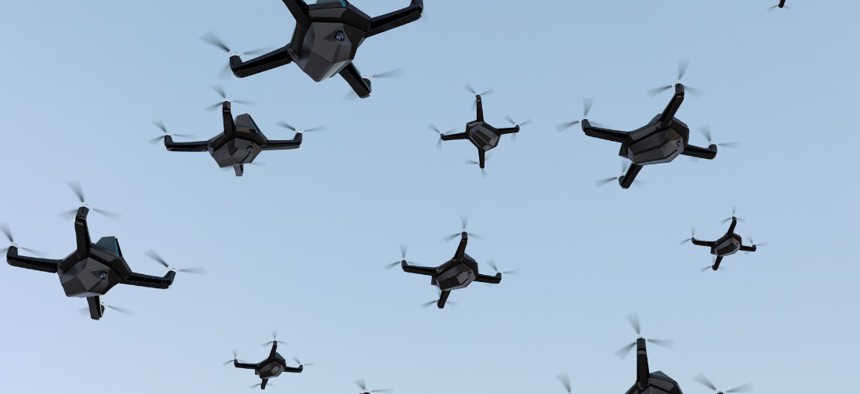Clouds of Smart Robots Swarm into Reality

Chesky_W/istockphoto
These bees aren't making honey.
Last year I wrote about how the government was developing and improving upon the fascinating science of drone swarms. Agencies were researching new areas to look for inspiration, like how swarms of bees interact with one another and then take coordinated action for the benefit of their hives. The idea was to collect that data and use it to help program fleets of robots and drones so that they could act in a swarm to collect information and perform tasks much more quickly than a single unit, or in some cases accomplish things that a single drone simply couldn’t do on its own.
For the most part, the testing of drone swarms was mostly done using simulations, though some agencies had big plans for the technology. The military is of course highly interested in adding a drone swarm capability, and some civilian agencies like NASA have plans to use swarm technology for tasks like coordinating the actions of weather satellites and giving them a degree of autonomy about how they act and what they study.
While an interesting concept, it was all pretty much theoretical–until now. Raytheon was able to demonstrate an active drone swarm operating in a real world environment during the fifth OFFensive Swarm-Enabled Tactics (OFFSET) DARPA program field exercise.
The swarm operated by Raytheon consisted of 130 physical devices backed by 30 simulated drone platforms. Like with almost any swarm, that is way too many craft for a single drone operator, or even a small team, to try and individually control each unit. A big part of the effectiveness of a drone swarm is its ability to operate independently once given a command or an objective by a human operator. Each drone also needs to effectively communicate with others, with the so-called hive mind assigning cooperative goals to individual units and making sure that they support one another.
“Controlling a drone swarm changes the way an operator or group of operators think about the drones,” said Shane Clark, Raytheon BBN OFFSET principal investigator. “Takeaways from this exercise help inform us of the inflection points between utility and manageability.”
The DARPA exercise was conducted in both outdoors and urban settings. The drone swarms consisted of ground-based vehicles and flying aircraft working in tandem. They also made use of another swarm advantage: the fact that individual swarm members are both cheap and expendable. For example, a swarm of 550 drones is just about as powerful and flexible as a swarm of 600, even if the former has “lost” almost 10% of its initial strength.
Because of their expendability, most units in a drone swarm will not be made of extremely expensive hardware bristling with sensors like you might find in an advanced military drone designed to operate alone. In terms of a swarm, it is the collective mass of units that is important, and not so much individual members. The Raytheon swarm robots were constructed using a scalable, modular combination of inexpensive commercial off-the-shelf and custom-built hardware and software to deliver swarm autonomy. Each drone was equipped with sensors that enabled it to explore its environment and also the ability to communicate with other drones in the swarm to coordinate actions.
What the drones were able to accomplish at the exercise is impressive. “Our software is smart enough to assign drones with the right capabilities to the appropriate set of tasks,” Clark said. “For example, if the task is to surveil a building, multiple drones will be dispatched with each surveilling portions of the building. The software considers each platform’s sensor capabilities, and tasks drones with downward facing cameras to surveil the roof.”
Meanwhile, the swarm operator is watching everything using a virtual reality headset that shows various camera views. The software also consolidates all of the data coming in from the swarm and builds a virtual environment for the human operator. It’s easy to see what areas of the environment have been surveilled and assign the swarm to areas that have not yet been covered. The swarm’s AI also helps with that task too.
“You can look behind the building to access a view of drone locations for example and use the virtual reality environment to test and see if your mission is viable. We also developed a speech interface with the operationally deployed Tactical Assault Kit, or TAK, integration capability that enables the operator to act quickly while maintaining situational awareness over many systems simultaneously,” Clark said.
Should the new drone swarms start to get produced and deployed, they could really add to the military’s capabilities in the field without any risk to human life. And given how well they seem to be already operating in complex test environments, I think even the bees would be impressed.
The Raytheon team, which includes Smart Information Flow Technologies and Oregon State University will next show off their drone swarm technology in March at the Army Expeditionary Warrior Experiment 2022 event in Fort Gordon, Georgia.
John Breeden II is an award-winning journalist and reviewer with over 20 years of experience covering technology. He is the CEO of the Tech Writers Bureau, a group that creates technological thought leadership content for organizations of all sizes. Twitter: @LabGuys
NEXT STORY: Report: U.S. Tops Government AI Readiness Index



